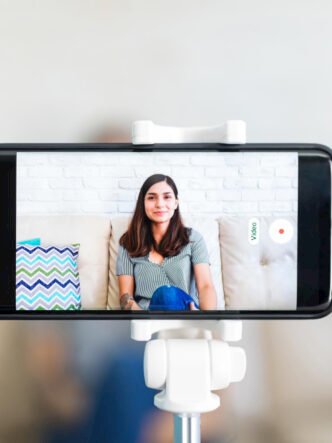If you are a course creator, coach, or part of a marketing team, you can create videos that educate while positioning your brand as a leader in your niche. Well-crafted educational video content can cut through the noise and create meaningful connections with your audience.
A great educational video helps your audience to solve their problems and gives them information so they can make better decisions. This establishes your company’s expertise and helps to build credibility and trust. Customers have more confidence in your products and services.
Educational content can also drive traffic to your website or social media, which can widen your audience base. When you make customers feel informed and empowered, they are more likely to stay loyal to your brand.

Why video is the most powerful educational format
Various statistics are available that show why educational videos are so powerful. Viewers retain 95% of a video’s message, whereas they only retain 10% when they read text. Studies show that a combination of audio and images makes information easier to recall than when scanning through lines of text.
- Educational videos that align with your brand voice and values help to reinforce brand recognition. When viewers connect emotionally with your content, they remember your brand. This means you don’t have to use a hard-sell approach.
- Interactive features in videos, such as quizzes, annotations, and calls to action, make learning active rather than passive. Whether you want viewers to complete a task, learn a new software tool or take a quiz, a call to action in a video can compel them to take action.
- Video content increases conversion rates on landing pages and in email marketing campaigns. Search engines prioritize video content, and websites with videos tend to rank higher in search results. This can drive more traffic and conversions.
- Videos offer personalized and accessible learning. You can personalize learning paths and appeal to diverse learning styles when using educational videos.
When using educational videos to build your brand authority, it’s important to use the right video hosting platform. The Cincopa platform allows you to create, host, store, and distribute educational videos.
Content types that build authority
Tutorials
Tutorials can teach viewers and offer them genuine value. They can range from those that offer quick tips to more in-depth videos. They attract those actively looking for information. For example, some companies offer an extensive library of tutorials for customers to access. This can drive online engagement and in-store visits.
Explainer videos
Explainer videos help to simplify complex concepts, products, or services. You can use animation or motion graphics to help viewers understand what you have to offer. They can improve the customer journey by answering questions and showing value. Any business with concepts that require explanations, such as tech companies, can make good use of them. An example is the Dropbox explainer video that articulates the problem and the solution it offers in less than three minutes.
Webinars
A webinar allows you to showcase your expertise and connect with your audience. Potential customers can engage with your brand from anywhere. An engaging and informative webinar can help you to build trust with potential customers and generate qualified leads.
Customer testimonial videos
Your real customers share their positive experiences when using your products or services. Hearing from these real customers increases trust more than you can with your own marketing efforts.
How to structure educational video content for credibility and clarity
To create impactful educational videos that build brand authority, you need to follow certain best practices.
Define your goal
Before you start creating a video, you need to define its goal. Do you want it to drive brand awareness? This will inform your approach and help you to measure your success.
Know your audience
Your educational videos must address the needs, problems, and preferences of your target audience. This will involve considering demographics, viewing habits, and the stage buyers are in their journey.
Focus on storytelling
Storytelling is one of the best ways to make educational videos engaging. It makes the information easier to absorb and more memorable.
Keep videos concise
Short, concise videos are easy to consume. Most brand videos should be under two minutes and you must capture the attention of viewers within the first 10 seconds. The ideal length of a video will depend on the platform you want to use it on, the type of content, and its purpose.
Prioritize quality
If you create low-quality videos, it will reflect negatively on your brand image. You don’t need the latest, most expensive equipment. You can even get excellent footage on a smartphone today. If you ensure lighting is good and audio is clear, this will impress viewers more than using the right model of camera.
Optimize videos for mobile viewing
Make sure videos are mobile-friendly and offer good quality even on small screens. Most content is viewed on mobile devices today.
Test and refine
Use analytics to understand which videos perform best and why. This enables you to keep adapting and improving your video content. You should track metrics that align with your goals, such as engagement rate, click-through rate, and conversions. You can calculate ROI when you compare outcomes against production and distribution costs.

Distributing videos across platforms
Creating great branded video content is only half the battle—distributing it effectively is equally important:
Email integration
Videos in email campaigns can increase click-through rates by 200-300% (Campaign Monitor). Include video thumbnails with play buttons linking to landing pages with embedded videos.
Website embedding
Strategically place videos on high-traffic product and landing pages to increase time-on-site and conversion rates.
Platform-specific optimization
- YouTube: Optimize for search with keyword-rich titles, descriptions, and tags. Create custom thumbnails and longer-form content (3-10 minutes).
- Instagram: Focus on visually striking first frames, square or vertical formats, and shorter content (under 60 seconds for feeds, up to 10 minutes for IGTV).
- TikTok: Embrace trends, use popular music, and create authentic, entertaining content in under 60 seconds.
- LinkedIn: Professional content performs best, with optimal length between 30 seconds and 2 minutes.
- Facebook: Focus on emotionally engaging content that drives shares, with optimal length between 1-3 minutes.
Cross-channel strategy
Repurpose content across platforms by adapting formats, lengths, and messaging to suit each platform’s unique audience and best practices.
Consistency matters more than frequency. A regular schedule your team can maintain—whether weekly, biweekly, or monthly—will perform better than bursts of content followed by silence.
Cincopa enables users to host and share branded educational video content with built-in analytics and lead capture tools to measure performance and impact.
Conclusion: Educate first, sell later
Branded video content has evolved from a nice-to-have marketing asset to an essential component of any comprehensive brand strategy. Video’s versatility allows it to address multiple marketing objectives simultaneously – building awareness, educating prospects, nurturing leads, and driving conversions.
Its ability to communicate on both rational and emotional levels makes branded video content particularly powerful. Brands that invest in high-quality video content that genuinely serves their audience’s needs, whether through entertainment, education, or inspiration will stand out from competitors who rely solely on traditional advertising approaches.









